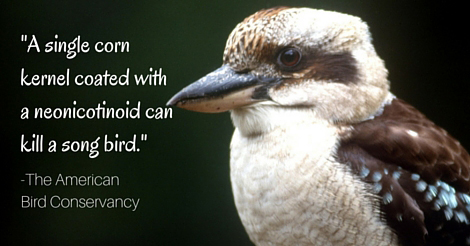Today is World Water Day. What do bees have in common with birds, crayfish, beetles, dragon flies, and crabs? All of these species, and countless others, are at risk from the harmful impacts of neonicotinoid (“neonic”) insecticides. Within the last several decades, the use of highly toxic, persistent insecticides—largely neonics—has become one of the greatest threats to aquatic and terrestrial ecosystems.
Last September, Center for Food Safety (CFS) released a new report, “Water Hazard: Aquatic Contamination by Neonicotinoid Insecticides in the United States,” highlighting the alarming contamination of water bodies across the U.S. as a result of widespread uses of neonics. Many people are familiar with the devastating effects that neonics have on bees and other pollinators—but often unseen are the disturbing consequences from the heavy use of these chemicals on entire food chains and ecosystems. As this new report conveys, there is validity to the concern that we are approaching an ecological crisis—a second Silent Spring.
How did we arrive at this situation?
We’ve been using toxic insecticides for decades —so what has changed? One of the biggest changes has been the ways in which we are applying these chemicals. The largest single use of neonicotinoids is as a seed coating for annual field crops (like corn, soybeans, and cotton), planted on at least 150 million acres across the U.S. More alarming than the vast acreage that we’re using these products on, is the fact that when used as a seed coating, much of the chemical doesn’t actually enter the crop itself. For corn seeds, up to 95 percent of the neonicotinoid coated on the seeds ends up in the surrounding environment, rather than in the plant for which it was intended. What is worse is that recent science indicates seed coatings provide little to no benefit to farmers, making their frequent and increasing use all the more troubling (see CFS’s report “Heavy Costs” for more on this).
After neonics are applied, whether as a seed coating, pesticide spray, or otherwise, the remaining residues runoff, both above and below ground, far beyond the agricultural fields, gardens, trees, lawns, and other areas where they were first applied. This leads to unintended effects on critical species across a vast array of wetlands and water bodies. Since neonics are slow to break down, they quickly build up in the environment, particularly in water bodies, and endanger a wide range of animals—everything from bees and butterflies, to lady bugs, birds, and even bats.

Far-reaching damages from neonicotinoid contamination
Sadly, birds are one of the groups most at risk from both direct and indirect exposures to neonics. Birds are susceptible to dying from eating coated seeds and ingesting the toxic chemicals, and they’re also at risk of starvation in areas where neonics have all but eliminated the aquatic and terrestrial insects critical to their diet. Recent science corroborates these concerns. For instance, research in Holland shows that neonicotinoid water contamination correlates significantly with bird population declines, with sparrows, swallows, and thrushes among the most-impacted species.
Preliminary research has also found neonicotinoids to be harmful to blue crabs and other marine species. Furthermore, because of their propensity to leach, neonics may also affect the wells and entire aquifer systems that people rely on as a source of freshwater. In New York State’s Suffolk County, for example, one particular neonicotinoid (imidacloprid) was the 3rd most frequently detected pesticide in groundwater, with 446 detections, and the 6th most frequently detected pesticide in public water, with 315 detections (60 of which were wells). This is despite several restrictions and EPA label warnings about neonicotinoid use aimed specifically at protecting Suffolk and Nassau counties from these chemicals. Contamination of New York’s vulnerable aquifers continues to occur.
Where do we go from here?
CFS proposes several policy recommendations to address this growing crisis (discussed in more detail in the full report), including calling for a suspension of neonicotinoid pesticide registrations due to their unreasonable adverse effects in aquatic ecosystems.
There is a reason bees are referred to as indicator species—their health (or lack thereof) is a strong gauge of the health of the broader environment. As this wealth of new research on aquatic ecosystems shows, many species beyond bees will remain at risk if we don’t address the problems with our current chemically-intensive agricultural system.
As Rachel Carson poignantly wrote, “Can anyone believe it is possible to lay down such a barrage of poisons on the surface of the earth without making it unfit for all life? They should not be called ‘insecticides,’ but ‘biocides.’” Neonicotinoids did not exist at the time Rachel Carson wrote these words in Silent Spring – and yet frighteningly her argument applies perfectly, more than 50 years later, to the current-day situation.





